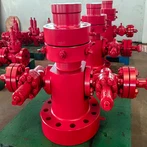In the oil and gas industry, the wellhead system is a crucial component that safeguards wellbores and operations. It is the equipment that connects the casing or tubing strings to the surface, controls the pressure and flow of fluids, and provides a means of accessing the well for maintenance, testing, and production. From a technical perspective, a wellhead system is a complex assembly of valves, connectors, seals, and sensors that must withstand high pressures, temperatures, and corrosive environments. From an operational perspective, a wellhead system is a critical interface between the subsurface and surface facilities, where any failure or malfunction can cause serious safety, environmental, and financial consequences.
To understand the wellhead system in detail, we need to explore its components, functions, and design considerations. Here are the key points to know:
1. Types of wellhead systems: Depending on the well configuration, there are various types of wellhead systems, such as conventional, dual completion, multilateral, and subsea. Each type has its own features and challenges, but all of them aim to provide a secure and efficient interface between the downhole and surface equipment.
2. Components of wellhead systems: A typical wellhead system consists of several components, including casing hangers, tubing hangers, casing heads, tubing heads, annular preventers, and ram blowout preventers. Each component has a specific role in supporting the weight of the casing or tubing strings, sealing the annular and bore spaces, regulating the flow and pressure of fluids, and preventing the uncontrolled release of hydrocarbons.
3. Design considerations for wellhead systems: Designing a wellhead system requires a thorough understanding of the well conditions, reservoir characteristics, drilling plan, regulatory requirements, and safety standards. Some of the key factors to consider are the well depth, pressure rating, temperature range, casing and tubing sizes, casing and tubing programs, well control system, and emergency response plan.
4. Examples of wellhead system failures: Unfortunately, wellhead systems can fail due to various reasons, such as corrosion, erosion, fatigue, manufacturing defects, human error, or natural disasters. Some of the consequences of wellhead failures are blowouts, spills, fires, injuries, fatalities, and environmental damage. For instance, the Deepwater Horizon incident in 2010 was caused by the failure of the wellhead system, which led to a massive oil spill in the Gulf of Mexico and a loss of 11 lives.
Overall, the wellhead system is a critical aspect of the oil and gas industry that requires careful planning, execution, and maintenance to ensure safe and efficient operations. Understanding the principles and practices of wellhead systems can help us appreciate the complexity and importance of this technology.
As a leading manufacturer of wellhead equipment, Vigor boasts a wealth of expertise and resources dedicated to delivering tailored solutions to meet your specific needs swiftly and effectively. Our extensive range of wellhead equipment, including API 6A and API 16A products, is currently operational in major oil fields worldwide, garnering positive feedback from our customers on-site. The Vigor team is committed to providing top-quality products and services that have earned unanimous acclaim from our clients. If you're looking for reliable wellhead solutions, we invite you to contact our dedicated team for expert assistance and to discover how Vigor can meet your requirements with professionalism and superior product quality.
For more information, you can write to our mailbox info@vigorpetroleum.com & mail@vigorpetroleum.com






